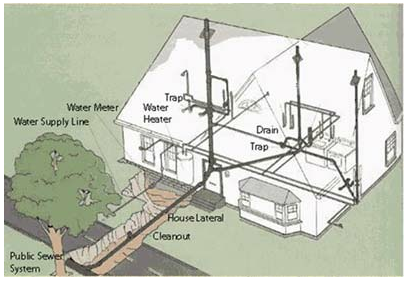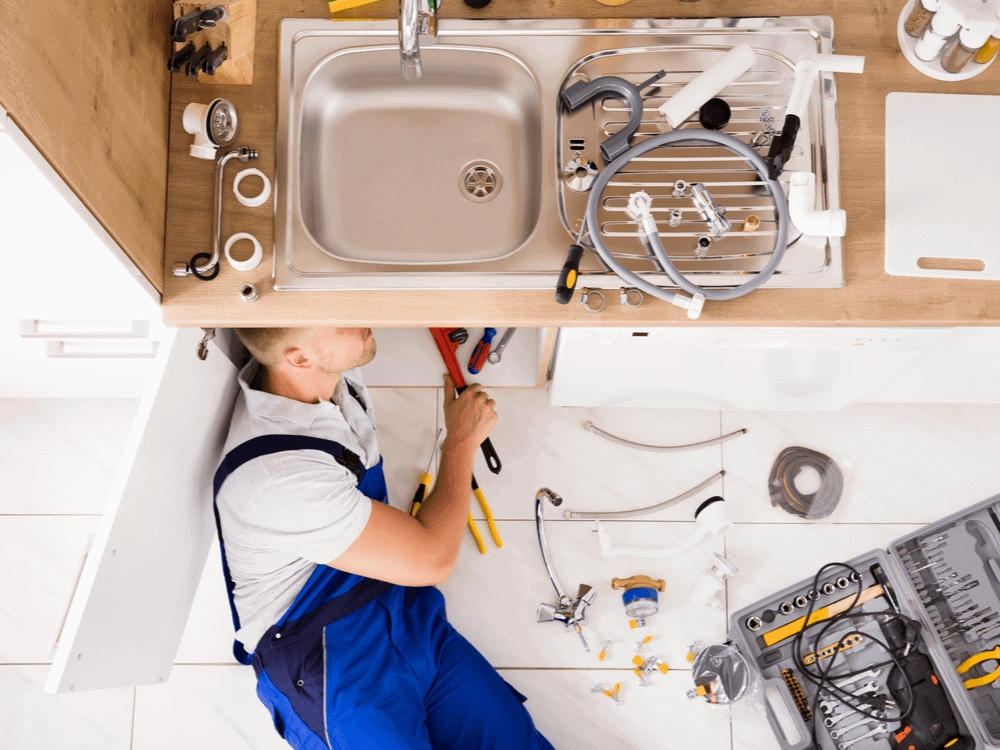Understanding The Anatomy of Your House's Plumbing System
Understanding The Anatomy of Your House's Plumbing System
Blog Article
The article on the next paragraphs involving The Inner Workings of Your Home's Plumbing is totally compelling. Have a go and draw your own personal results.

Recognizing just how your home's plumbing system works is necessary for each home owner. From delivering clean water for alcohol consumption, food preparation, and showering to safely removing wastewater, a well-kept plumbing system is crucial for your family's health and wellness and convenience. In this detailed overview, we'll check out the intricate network that makes up your home's plumbing and offer suggestions on upkeep, upgrades, and managing common issues.
Introduction
Your home's plumbing system is more than simply a network of pipelines; it's a complicated system that ensures you have access to clean water and efficient wastewater removal. Knowing its components and how they collaborate can help you protect against pricey fixings and make sure whatever runs smoothly.
Basic Elements of a Plumbing System
Pipes and Tubes
At the heart of your pipes system are the pipes and tubing that lug water throughout your home. These can be made from various products such as copper, PVC, or PEX, each with its advantages in regards to sturdiness and cost-effectiveness.
Fixtures: Sinks, Toilets, Showers, and so on.
Components like sinks, bathrooms, showers, and bathtubs are where water is made use of in your home. Recognizing exactly how these fixtures link to the plumbing system aids in identifying issues and intending upgrades.
Valves and Shut-off Points
Valves regulate the flow of water in your pipes system. Shut-off shutoffs are essential throughout emergencies or when you require to make repair services, allowing you to separate parts of the system without interrupting water flow to the entire house.
Water System System
Main Water Line
The primary water line links your home to the municipal water system or a private well. It's where water enters your home and is distributed to numerous fixtures.
Water Meter and Stress Regulator
The water meter actions your water usage, while a pressure regulatory authority makes sure that water moves at a safe stress throughout your home's pipes system, stopping damage to pipelines and components.
Cold Water vs. Hot Water Lines
Comprehending the difference in between cold water lines, which provide water directly from the major, and warm water lines, which carry heated water from the hot water heater, helps in fixing and preparing for upgrades.
Water drainage System
Drain Water Lines and Traps
Drain pipes bring wastewater away from sinks, showers, and commodes to the sewer or septic tank. Catches avoid drain gases from entering your home and additionally catch debris that might create clogs.
Air flow Pipelines
Air flow pipes allow air right into the drainage system, protecting against suction that could slow down water drainage and cause traps to empty. Correct ventilation is crucial for keeping the integrity of your pipes system.
Importance of Appropriate Drainage
Guaranteeing correct drainage stops back-ups and water damages. Frequently cleansing drains and preserving traps can prevent costly repair services and prolong the life of your pipes system.
Water Heating Unit
Sorts Of Hot Water Heater
Water heaters can be tankless or conventional tank-style. Tankless heating systems warmth water on demand, while storage tanks save heated water for instant usage.
Upgrading Your Pipes System
Factors for Upgrading
Upgrading to water-efficient components or changing old pipes can enhance water top quality, lower water costs, and increase the value of your home.
Modern Pipes Technologies and Their Advantages
Explore modern technologies like smart leak detectors, water-saving commodes, and energy-efficient hot water heater that can conserve cash and lower environmental impact.
Price Factors To Consider and ROI
Compute the upfront costs versus long-lasting cost savings when thinking about plumbing upgrades. Several upgrades pay for themselves via minimized energy costs and less fixings.
Exactly How Water Heaters Attach to the Plumbing System
Comprehending how water heaters connect to both the cold water supply and hot water distribution lines assists in diagnosing issues like not enough warm water or leakages.
Upkeep Tips for Water Heaters
Consistently purging your hot water heater to eliminate sediment, checking the temperature level settings, and inspecting for leaks can extend its life-span and boost power effectiveness.
Typical Pipes Issues
Leakages and Their Reasons
Leakages can happen due to aging pipes, loosened installations, or high water pressure. Addressing leaks promptly stops water damage and mold development.
Obstructions and Clogs
Blockages in drains pipes and commodes are typically caused by purging non-flushable items or a buildup of oil and hair. Using drainpipe screens and bearing in mind what drops your drains pipes can protect against obstructions.
Signs of Pipes Problems to Look For
Low tide pressure, slow-moving drains pipes, foul odors, or uncommonly high water costs are signs of possible plumbing problems that need to be attended to promptly.
Plumbing Upkeep Tips
Routine Examinations and Checks
Schedule annual pipes evaluations to catch issues early. Seek indications of leaks, deterioration, or mineral accumulation in taps and showerheads.
Do It Yourself Upkeep Tasks
Basic tasks like cleansing faucet aerators, looking for bathroom leakages utilizing dye tablet computers, or insulating subjected pipelines in cold environments can prevent major plumbing problems.
When to Call a Professional Plumbing Professional
Know when a plumbing concern requires specialist know-how. Attempting complex repair services without proper expertise can lead to even more damages and higher fixing prices.
Tips for Minimizing Water Usage
Basic habits like taking care of leaks quickly, taking much shorter showers, and running full tons of washing and recipes can conserve water and reduced your utility costs.
Eco-Friendly Plumbing Options
Take into consideration sustainable pipes products like bamboo for flooring, which is durable and green, or recycled glass for countertops.
Emergency Readiness
Steps to Take During a Pipes Emergency
Know where your shut-off valves lie and how to shut off the water in case of a burst pipeline or significant leakage.
Significance of Having Emergency Situation Contacts Useful
Maintain contact info for neighborhood plumbers or emergency solutions conveniently available for quick reaction during a plumbing dilemma.
Environmental Effect and Preservation
Water-Saving Fixtures and Home Appliances
Setting up low-flow faucets, showerheads, and commodes can dramatically decrease water use without compromising efficiency.
DIY Emergency Fixes (When Relevant).
Temporary repairs like utilizing air duct tape to spot a dripping pipeline or putting a container under a leaking faucet can reduce damage up until a professional plumbing arrives.
Verdict.
Understanding the makeup of your home's plumbing system empowers you to keep it properly, conserving money and time on repair services. By complying with normal maintenance routines and staying educated regarding contemporary plumbing modern technologies, you can guarantee your plumbing system runs successfully for years to come.
The Anatomy of Your Home s Plumbing System
Understanding the anatomy of your home s plumbing system is essential for any homeowner. It not only helps in identifying potential issues but also facilitates effective communication with professionals when repairs or upgrades are needed. Your home s plumbing system is more than just pipes and faucets; it s a complex network that ensures the efficient and hygienic flow of water in and out of your house. In this blog, we ll dissect the crucial components of your home s plumbing system. For those in Antelope Valley, Brock Plumbing is your trusted partner for all your plumbing needs, ensuring your system functions smoothly and efficiently.
Water Supply System
Main Water Line: This is where your home s plumbing system begins. The main water line connects your home to the public water supply or a private well. Pipes and Shut-off Valves: Pipes distribute water throughout your home. Shut-off valves are crucial for controlling the flow of water and making repairs without shutting off the entire system. Drainage System
Drain Pipes: These pipes carry waste and water away from sinks, toilets, and showers. Vents: Vents allow sewer gases to escape and help maintain proper pressure in the drainage pipes, ensuring efficient flow of wastewater. Traps: Every fixture has a trap, a U-shaped pipe that holds water and prevents sewer gases from entering your home. The most common is the P-trap under sinks. Fixtures and Appliances
Fixtures and appliances are the most interacted with parts of your plumbing system. They include sinks, toilets, showers, dishwashers, and washing machines. Each fixture and appliance has its own supply and drainage connection, ensuring they receive clean water and can dispose of wastewater effectively.
Water Heating System
Your water heater is a crucial component, providing hot water to various fixtures and appliances in your home. It can be tank-based or tankless, with each type having its own set of advantages and maintenance requirements. Regular maintenance is essential to ensure efficient operation and extend the lifespan of the unit.
Sump Pump
In areas prone to flooding or with high water tables, a sump pump is an essential part of the plumbing system. It s installed in the lowest part of your basement or crawlspace and pumps out water that accumulates, preventing flooding and protecting your home from water damage.
Septic System
Homes that are not connected to a municipal sewer system have a septic system and an underground wastewater treatment structure. Understanding how to maintain your septic system is crucial to prevent backups, odors, and early system failure.
Conclusion
Your home s plumbing system is a complex and essential network, ensuring the efficient and hygienic flow of water in and out of your property. Understanding its key components helps in maintaining it properly and identifying issues before they escalate into major problems. For residents in Antelope Valley, Brock Plumbing is dedicated to providing top-notch services, ensuring that every part of your plumbing system is in perfect working order. Trust our team of professionals to handle all your plumbing needs, ensuring your home remains comfortable, safe, and well-maintained.
https://brockplumbinganddrains.com/blog/the-anatomy-of-your-homes-plumbing-system/

We had been shown that editorial on Understanding Your Home's Plumbing Anatomy through a pal on our other site. Liked our review? Please quickly share it. Help other people find it. We cherish reading our article about The Inner Workings of Your Home's Plumbing.
Click Here Report this page